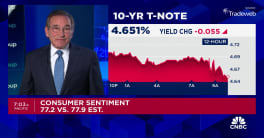U.S. existing home sales fell more than expected in June, and a third of those sales come from foreclosures, according to the National Association of Realtors (NAR) on Thursday. Economists say rising inventories suggest problems in the housing market are yet to see a turnaround any time soon.
The index for existing homes fell 2.6% to 4.86 million units in June following May's unrevised sales figure of 4.99 million, marking the fourth straight month sales have remained under the five million mark.
T.J. Marta, fixed income strategist at RBC Capital Markets, noted the index reached a new low in the series, which dates back to 1999. He said part of the reason for the monthly decline likely derives from an increase in prices.
The national median existing home price rose to $215,100 in June, up from the May figure of $207,900 but down 6.1% from a year ago.
"Sales will only pick up enough to burn off the excess inventories with another leg down in prices, and this will lead to another round of hits to personal balance sheets," Marta added.
Since June 2007, existing home sales have declined by 15.5%, and with housing inventories rising to an 11.1-month supply in this survey, economists say there's no end in sight for the housing decline.
"The U.S. housing market continues to be very weak, and with the inventory of unsold homes continuing to rise we are unlikely to see any meaningful turnaround in the sector in the near term," said Millan Mulraine, economics strategist at TD Securities.
Single-family unit sales, which make up four-fifths of the market, fell 3.2% to 4.27 million, down from a rate of 4.41 million in the previous month.
The NAR said foreclosures represent one-third to 40% of all sales and cause a downward distortion to the price data.
"With short sales and foreclosures accounting for approximately one-third of transactions, it's hard to make an apples-to-apples comparison with a year ago when they were only a minor portion of the market," said Lawrence Yun, NAR chief economist.
Ian Shepherdson, chief U.S. economist at HFE, said, "We still think home sales have some way yet to fall but they are not going to keep dropping at the June pace."
According to Freddie Mac, the national average for a fixed-rate 30-year mortgage rose to 6.32% in June from 6.04% in May; the rate was 6.66% in June 2007.
Treasury markets rallied on the release with yields on two-year notes falling 4 bps to 2.685% before rebounding to 2.71%, while yields on ten-year notes declined 3.5 bps to 4.05%. The September Eurodollar contract spiked 5 bps to 96.235 before retracting to 96.20.
Against the euro, the greenback sold off four tenths of a cent to 1.5714 before retracing losses. The USD failed to move significantly against the Canadian dollar.
Existing home sales, which include single-family homes, townhomes, condominiums and co-ops, are based on transaction closings. This differs from the U.S. Census Bureau's series on new single-family home sales, which are based on contracts or the acceptance of a deposit.
The next major indicator for the U.S. housing market comes out Friday, when the Census Bureau will release its new homes sales index.
By Patrick McGee and edited by Nancy Girgis







